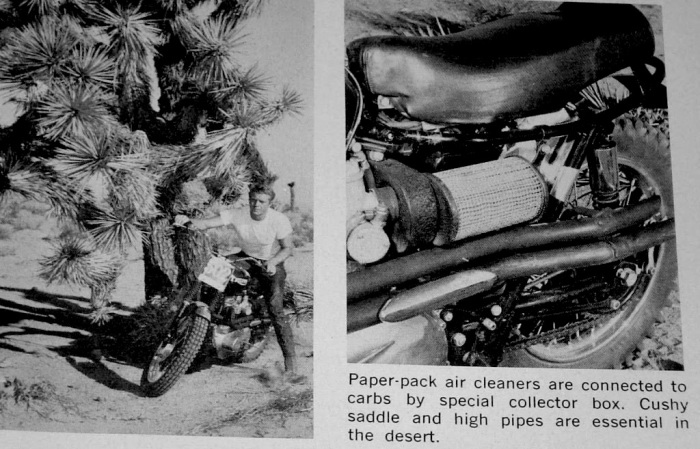Nostalgia on Wheels posted these incredible pictures (quite a while back) of Steve McQueen and his Bud Ekins’ desert-modified Triumph Bonneville racer from the June 1964 edition of Cycle World Magazine. Original photos by Cal West. I re-typed the original text so it’s legible, great stuff. Hells. Yes.
“Actor Steve McQueen and his Triumph desert bike in their native habitat.” –Cycle World Magazine, June 1964
–
“Many modifications make a desert bike. Crossovers, skid plate, giant filters, etc.” –Cycle World Magazine, June 1964
–
“Paper-pack air cleaners are connected to carbs by special a collector box. A Cushy saddle and high pipes are essential in the desert.” –Cycle World Magazine, June 1964
–
“IN McQUEEN’S SERVICE”
Winning desert races is what this machine was set up for. It is the mount of actor Steve McQueen, who recently won the novice class in a one-hour desert scrambles. The victory only proved what a close look at his Triumph Bonneville suggests: McQueen takes his motorcycling seriously.
It takes some modifications to wing the rough, dusty hare ‘n hounds, scrambles and enduros that are popular in the southwestern desert. McQueen’s machine was prepared in Bud Ekins’ Sherman Oaks, California shop. They started by replacing the stock wheel with a 1956 Triumph hub and 19″ wheel to reduce unsprung weight. The forks were fitted with sidecar springs and the rake increased slightly by altering the frame at the steering crown. The rear frame hoop was bent upward to accommodate a 4.00 x 18 Dunlop sports knobby, and to it were welded brackets for the Bates cross-country seat. The bars are by Flanders, with leather hand guards, and the throttle cables run over the tank, through alloy brackets to the twin 1 1/8″ Amal carburetors.
A Harlan skidplate protects the underside of the motor, the footpegs were braced, and the rear brake rod was increased to 5/16″ diameter and rerouted inside the frame and shock (where sagebrush can’t damege it). The oil tank was modified to increase its capacity and bring the filler out the side fom under the seat. It also serves as part of the mudguard, saving weight.
The engine is basically a stock Bonneville but the compression was lowered from 12 : 1 to 8 1/2 : 1 for reliability, and the sagebrush-snagging oil pressure indicator was converted to a pop-off relief valve with a return line back to the oil tank. McQueen runs Jomo TT cams and Lode RL47 Platinum tip plugs.
The important job of filtering all that dirt out of the desert air is handled by paper-pack air cleaners connected by a special collector box to the carbs. This box is finished in black wrinkle-finish paint while the tanks are dark green. The cross-over pipes are Ekins’ own design, and are left unplated for better heat dissipation. Perhaps if McQueen were riding this motorcycle in the movie, he would have made his “Great Escape.”
–Cycle World Magazine, June 1964
–
“Terrence Steven McQueen received a red tricycle for his fourth birthday from his great uncle, and on that day a racing legend was born. Before joining the Marine Corps, he worked as an oil rigger, in a carnival, and as a janitor in a brothel. When he was honorably discharged in 1950, McQueen started taking acting workshops. To pick up some extra cash, he started competing in motorcycle races on the weekends. In late 1955, at the age of 25, McQueen left New York and headed for California where his motorcycle-racing buddy Robert Culp helped him land his first TV role.
McQueen also competed in off-road motorcycle racing. His first off-road motorcycle was a Triumph 500cc that he purchased from friend and stuntman Bud Ekins. In McQueen’s 1963 film The Great Escape, he rode a Triumph TR6 650 and, in one of the most famous action scenes in a movie, his character escaped the Nazis by jumping over a fence – which Bud did the stunt for.
In addition to starring in movies like Bullitt and The Getaway, McQueen raced in many top off-road races on the West Coast, including the Baja 1000, the Mint 400 and the Elsinore Grand Prix. In 1964, together with Bud Ekins on their Triumph TR6 Trophys, he represented the United States in the International Six Days Trial, a form of off-road motorcycling Olympics. He was inducted into the Off-Road Motorsports Hall of Fame in 1978.
In 1971, McQueen’s production company funded the now-classic motorcycle documentary “On Any Sunday”, in which McQueen is featured along with racing legends Mert Lawwill and Malcolm Smith. Steve McQueen owned over 200 bikes in his lifetime, and he was posthumously inducted into the Motorcycle Hall of Fame.” –via Triumph
–
Steve McQueen on his 1963 Triumph Bonneville Desert Sled built by McQueen’s good friend, Bud Ekins.
 Steve McQueen’s pickup truck loaded-up with his Bud Ekins’ desert-modified Triumph Bonneville desert racer.
Steve McQueen’s pickup truck loaded-up with his Bud Ekins’ desert-modified Triumph Bonneville desert racer.
.
In 2009, Steve McQueen’s 1963 Triumph Bonneville Desert Sled sold at Bonhams & Butterfields’ first-ever motorcycle and memorabilia auction for $84,240. The bike was personally built by McQueen’s good friend, Bud Ekins, the famous stunt rider and off-road racing champ, and was painted by another legend– the epic painter, striper, builder, fabricator, etc., Von Dutch.
–
–






I use to visit that 63 Desert Sled weekly… it was in a motorcycle museum here in vancouver canaduh for years… After a bad day at work I would stop in at the museum on my way home (museum was free) and touch the seat. A little creepy, I know, but it helped!
Great article, Thank you for your efforts. The more I read about him the more I like him. .
good stuff as always
He (Mr. McQueen that is) did a pretty fair sportscar racing film some of you may remember called “LeMans” for obvious reasons.